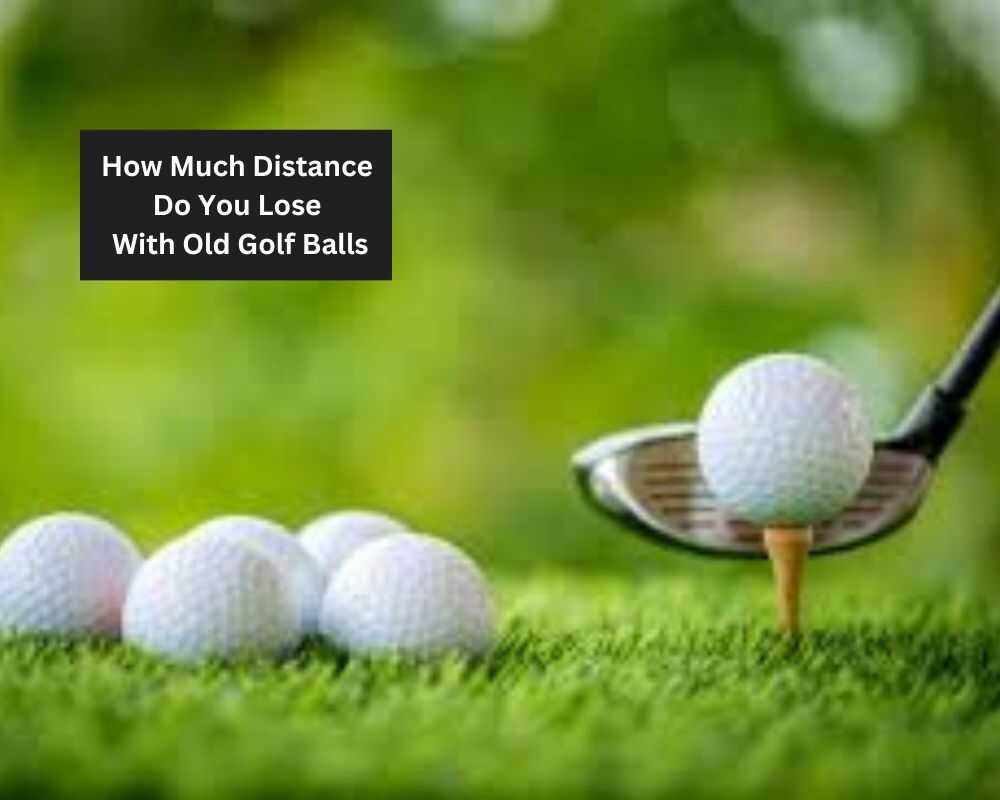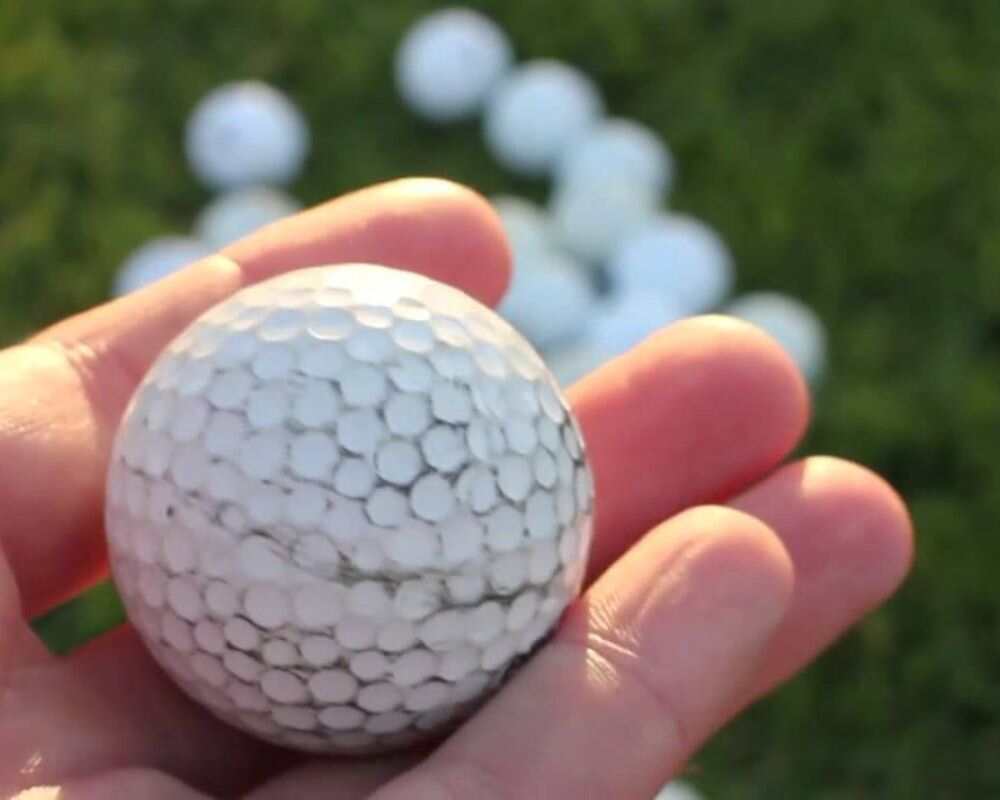Golfers often complain that their old golf balls become too soft or don’t cover the expected range. But is it actually a valid claim and how much distance do you lose with an old golf ball?
A golf ball can last over 10 years if it is stored properly. Age actually doesn’t impact on the game. But wear, tear, water damage, and overall poor storage affect the ball and ultimately your game.
Yet, we’ll say old golf balls lose distance but by many yards. Additionally, modern balls are designed with advanced technology to provide improved performance where aging doesn’t matter.
How Much Distance Do You Lose With Old Golf Balls?

Old golf balls lose distance but not significantly. Likely, if you store a golf ball aged about 10 years at room temperature, it will lose 0.5 to 1 percent velocity. Result the ball will lose distance a few yards out.
Moreover, you can notice minor scuffs on the used golf balls. When you hit the ball with the golf club repeatedly, these scuffs are formed on the surface. If the scuffs are intense, they will lead to a measurable loss in distance. Sometimes, the distance loss is as much as 6 yards.
However, there are lots of tests done between new balls and old balls and there is no significant impact on their distance and performance.
Many pro golfers often change balls in every hole. But it does not mean that they are bad. The truth is more based on some superstition than their quality.
Additionally, many other conditions affect the ball and ultimately lose distance. Aging is not the main factor. We’ll explain the other factors in the below section.
When do Golf Balls Start To Lose Distance?
Usually, a golf ball’s core can endure approximately 100 golf strokes at speeds of 125 miles per hour before showing signs of wear and potential cracking. So the endurance level is suitable to cover seven full rounds of 18 holes.
Once a golf ball reaches this point, it’s wise to replace it with a new one for optimal performance. It’s important to note that if your golf ball becomes visibly cut, cracked, or deformed during play, you should immediately change it with a new ball.
In the PGA tours, they follow one ball rule which means golfers can use only one specific golf ball throughout a round. Therefore, it is always important to check the rules of the course.
It’s worth mentioning that, in most cases, golf balls are quite durable and can last for several decades. Surprisingly, it’s often the elements rather than usage that pose the biggest threat to their durability.
As you play golf, wear and tear on your golf balls are unavoidable. However, this is a natural consequence of enjoying the sport. Proper storage, though, can significantly extend the lifespan of your golf balls, allowing them to remain in good condition for many years.
Why Does A Golf Ball Lose Distance?

There are many factors that cause a golf ball to lose distance. For example:
1. The Cold Effect
Playing golf in cold weather is challenging. It’s not just because of the freezing temperatures, it’s a simple science. Cold air is denser, which means it creates more resistance for your golf ball as it travels through the atmosphere. As a result, the ball loses speed, and as we all know, speed is directly linked to distance.
In scientific terms, the relationship between speed, distance, and time is expressed as speed = distance / time. When the ball’s speed decreases due to the cold, it inevitably leads to a reduction in distance.
To maximize your golf ball’s performance, it’s advisable to store them at temperatures between 70 and 80 degrees Fahrenheit. Extreme cold, like 40-degree temperatures, can lead to a significant loss of 5 to 10 yards in distance.
2. Sticky Mud
If mud or debris sticks to your golf ball, it can lose both distance and accuracy. When your ball is coated in mud, it can affect its flight trajectory and shape, leading to a decrease in both distance and precision. For instance, mud on the top of the ball can cause excessive spin, resulting in the ball ballooning in the air and ultimately losing distance. So, you need to clean the golf ball properly after every game play.
3. Wind
Wind is a formidable force in golf that can either boost or hinder your golf ball’s distance. Golfers must consider wind speed and direction when taking their shots. The key principle to remember is that if your shot aligns with the wind’s direction, it will gain speed, thus increasing its overall distance.
Conversely, if the wind opposes the intended path of your shot, expect a decrease in both speed and distance. For example, if you’re attempting a draw shot (or a slice for left-handed players) and the wind blows from right to left, your golf ball is likely to travel farther.
4. Waterlog
If balls are submerged in water for a long time, water can seep through the outer layer. It causes significant damage to the balls. They are also called waterlogged golf balls. Research shows that even after just 12 hours in the water, the outermost layer of a golf ball allows water to penetrate inside.
If a golf ball remains in a water hazard on the course for over a week, it can lose 5 to 10 yards in driving distance off the tee. After three months in the water, that distance reduction can be a staggering 20 to 30 yards.
Clearly, it’s not advisable to leave your golf ball soaking for such extended periods. Even if a waterlogged golf ball dries out, it still won’t perform as well as one that has never been submerged. The longer it stays in the water, the more it loses its ability to fly.
How to Properly Store Your Golf Balls?
It’s hard to believe that a golf ball can last for a decade. While they can last for 10 years, proper storing systems come into account. If you store them in the correct way, the balls won’t lose momentum. Here are some tips:
Dry and Clean: Before storing your golf balls, make sure they are clean and dry. Any dirt, moisture, or grass on the balls can lead to mold or damage over time. Wipe them down with a clean cloth to remove any debris.
Use a Container: Invest in a golf ball container or storage bag. These are designed to protect your golf balls from external elements and maintain their condition. Airtight containers or bags with a zipper seal work best.
Temperature Control: Store your golf balls in a cool, dry place away from extreme temperatures. Avoid leaving them in your car, garage, or any area where they might be exposed to direct sunlight or extreme cold. Temperature fluctuations can affect the ball’s performance and durability.
Avoid Water Exposure: Keep your golf balls away from water or moisture. Excessive moisture can lead to mold growth inside the balls. If your golf balls get wet during a round, dry them thoroughly before storing them.
Check Regularly: Periodically inspect your stored golf balls for any signs of damage or wear. If you notice any cracks, cuts, or deformities, it’s best to discard those balls as they won’t perform as expected.
How Often Should You Replace Your Golf Balls?
The lifespan of a golf ball is surprisingly long, often stretching into decades if well-maintained. Unlike a fixed schedule, the decision to replace your golf balls hinges on their visible condition, particularly surface damage.
One of the most evident signs for a golf ball replacement is the presence of scuffs and bumps on its outer layer. These imperfections seem minor, but they can significantly disrupt the ball’s aerodynamics. The dimples on a golf ball play a crucial role in its ability to travel straight and cover a substantial distance.
When these dimples are compromised due to surface damage, achieving the desired distance becomes challenging. It’s important to remember that golf ball distance depends on various factors, but the condition of the ball’s exterior has a substantial impact.
Therefore, as you inspect your golf balls, keep an eye out for any scuffs or bumps on their surfaces. When you notice such damage, it’s a clear signal that it’s time to consider replacing them.
Frequently Asked Questions (FAQs)
What Do You Do With Old Golf Balls?
There are several options for dealing with old golf balls. You can reuse them if they are not significantly damaged. You can donate them to junior golf programs or local schools. They may use them for practice or instructional purposes. Some golf courses and recycling centers accept golf balls for recycling.
How many hits can a golf ball take?
On average, a well-maintained golf ball can endure around 100 hits at a speed of 125 miles per hour before showing signs of wear or potential cracking. However, this number can vary.
How many rounds will a golf ball last?
The lifespan of a golf ball can vary, but on average, a golf ball can last for several rounds of play. A golf ball can maintain its performance for as many as seven full 18-hole rounds without any noticeable deterioration, provided there is no visible damage.
Can you store golf balls in a garage?
The ideal temperature for storing golf balls is between 70-80 degrees. If your garage has no temperature issue, then you can store them there. However, in winter, the garage may have a lower temperature which can damage the balls.
Should you use a new golf ball each round?
Using a new golf ball for each round is not a strict necessity for most golfers. As mentioned earlier, golf balls can last for several rounds, depending on factors like the ball’s quality and your swing speed. Many golfers, especially amateurs, choose to use the same ball for multiple rounds.
Conclusion
The age and condition of your golf balls can affect the distance you achieve on the course. While it’s challenging to pinpoint an exact number, it’s safe to say that using fresh, high-quality golf balls. It will help you to maximize your distance and improve your overall golfing experience.
